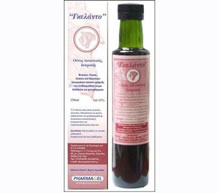
Λεξικό .. Anti-IgE and allergic rhinitis
Intermittent allergic rhinitis (Seasonal Allergic disease, SAR) is a frequently underestimated disease with regards to impairment of quality of life (QOL) of the patients, who experience a significant level of morbidity. Allergen avoidance as a means of secondary intervention is difficulty to achieve for patients with SAR, who are often sensitized to multiple outdoor allergens. So far, SIT is the only available curative approach [1], but its application is restricted with regard to polyzensitized and very young patients. But especially the polysensitzed group of patients require therapy for several months of the year and suffer most from decreased QOL and reduced productivity at the school or in the working place [2]. Despite optimized treatment regimens, including antihistamines, corticosteroids, or mast cell stabilizers, many patients with SAR still have suboptimal symptom control [3]. Therefore, new treatment options targeting more specifically and early in the allergic cascade are desirable. SAR clearly is a mainly IgE-mediated disease, in which chronic inflammation and remodelling of anatomical structures are not as important as in asthma. The immediate hypersensitivity reaction to environmental allergens, triggered by allergen-specific IgE and IgE-mediated mast cell activation, is the basic pathophysiological correlate to the symptoms apparent in patients with SAR. Thus, targeting IgE is a plausible way of preventive therapy for SAR.
Clinical phase II and III trials investigating safety and efficacy of anti-IgE for treatment of SAR demonstrated that anti-IgE effectively reduces free serum IgE levels and allergen-related symptoms, and increases QOL. Moreover, anti-IgE is not allergen-specific and thus adds to the beneficial effects of SIT, a very significant improvement for the often multisensitized SAR patients, who suffer under long pollen seasons and frequent co-morbidity of the lower airways. In contrast to SIT, anti-IgE has the drawback that its effect may be transient, but the advantage that it is not allergen specific. Even more important, treatment with anti-IgE antibodies may help to zprevent the "allergic march", the development of allergen-mediated airway diseases such as bronchial asthma in patients with predisposing SAR. Effective control of SAR thus may provide preventive and/or therapeutic treatment of concomitant respiratory diseases[4]. Omalizumab is a humanized monoclonal anti-IgE antibody developed for the treatment of allergic disease, with established efficacy in patients with moderate-to-severe allergic asthma and in patients with intermittent (seasonal) and persistent (perennial) allergic rhinitis (AR).
Omalizumab is known to result in a marked reduction in serum levels of free IgE and down-regulation of IgE receptors on circulating basophils. Recent work has shed further light on its mechanism of action, showing significant and profound reductions in tissue (nasal and bronchial) eosinophils and in bronchial IgE+ cells (mast cells), as well as T cells and B cells. Omalizumab treatment was also shown to be associated with down-regulation of IgE receptors on circulating (precursor) dendritic cells, suggesting that blocking IgE may inhibit more chronic aspects of allergic inflammation involving T cell activation.
Further work with omalizumab demonstrated it to have important benefits in patients with poorly controlled asthma despite high-dose inhaled corticosteroid therapy, and analysis of clinical data suggests that the patients who are the best 'responders' to anti-IgE treatment are those with asthma at the more severe end of the spectrum. Notably, systemic anti-IgE therapy with omalizumab has been shown to improve symptoms, quality of life and disease control (asthma exacerbations) in patients with concomitant asthma and persistent AR. These impressive clinical data and the studies elucidating the anti-inflammatory profile of omalizumab also serve to emphasize the fundamental importance of IgE in the pathogenesis of allergic diseases [5, 6].
References
1. Lieberman P, Patterson R. Immunotherapy for atopic disease. Adv Intern Med 1974;19:391-411.
2. Malone DC, Lawson KA, Smith DH, Arrighi HM, Battista C. A cost of illness study of allergic rhinitis in the United States. J Allergy Clin Immunol 1997;99:22-27.
3. White P, Smith H, Baker N, Davis W, Frew A. Symptom control in patients with hay fever in UK general practice: how well are we doing and is there a need for allergen immunotherapy? Clin Exp Allergy 1998;28:266-270.
4.Boulet LP, Chapman KR, Cote J et al. Inhibitory effects of an anti-IgE antibody E25 on allergen-induced early asthmatic response. Am J Respir Crit Care Med 1997;155:1835-1840.
5. Hamelmann, E., Rolinck-Werninghaus, C. & Wahn, U. From IgE to Anti-IgE: Where do we stand?.Allergy 2002: 57(11):983-994.
6. Holgate ST, Djukanović R, Casale T, Bousquet J. Anti-immunoglobulin E treatment with omalizumab in allergic diseases: an update on anti-inflammatory activity and clinical efficacy. Clin Exp Allergy.2005 Apr;35(4):408-16
Γκέλης Ν.Δ. - Λεξικό Αλλεργίας - Εκδόσεις ΒΕΛΛΕΡOΦΟΝΤΗΣ - Κόρινθος 2013
Gelis Ν.D. - Dictionary of Allergies - VELLEROFONTIS Publications - Corinth 2013




